Encryption Technique in Cloud Computing - MITS50004 IT Security
VerifiedAdded on 2022/10/09
|9
|2427
|94
AI Summary
This report discusses the encryption technique used in cloud computing to protect user data stored on cloud platforms. It covers different encryption methods such as Attribute-Based Encryption, Key Policy ABE, Cipher text Policy ABE, Hierarchical Identity-Based Encryption, and more. The report also highlights the importance of data security in cloud computing and access control policies.
Contribute Materials
Your contribution can guide someone’s learning journey. Share your
documents today.
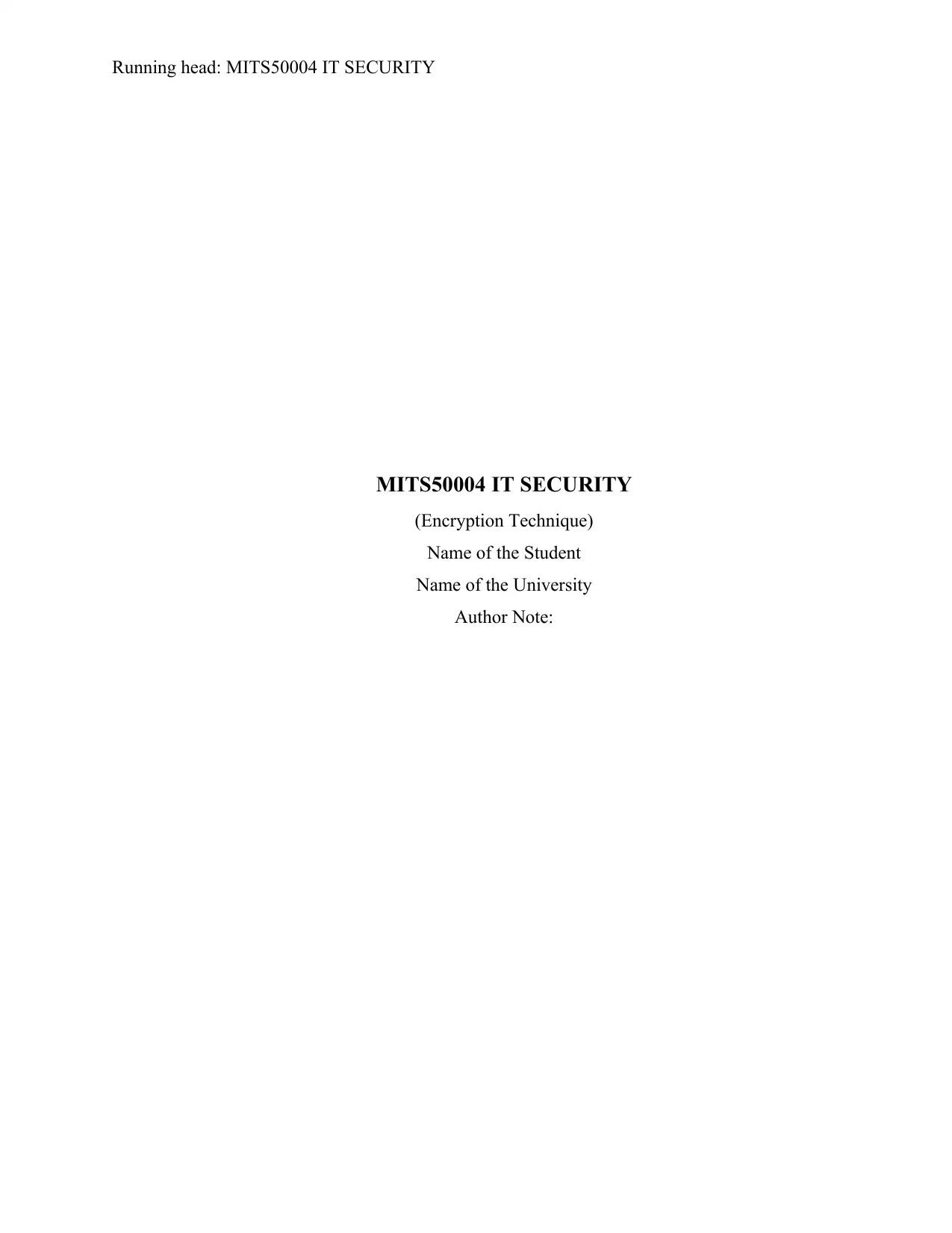
Running head: MITS50004 IT SECURITY
MITS50004 IT SECURITY
(Encryption Technique)
Name of the Student
Name of the University
Author Note:
MITS50004 IT SECURITY
(Encryption Technique)
Name of the Student
Name of the University
Author Note:
Secure Best Marks with AI Grader
Need help grading? Try our AI Grader for instant feedback on your assignments.
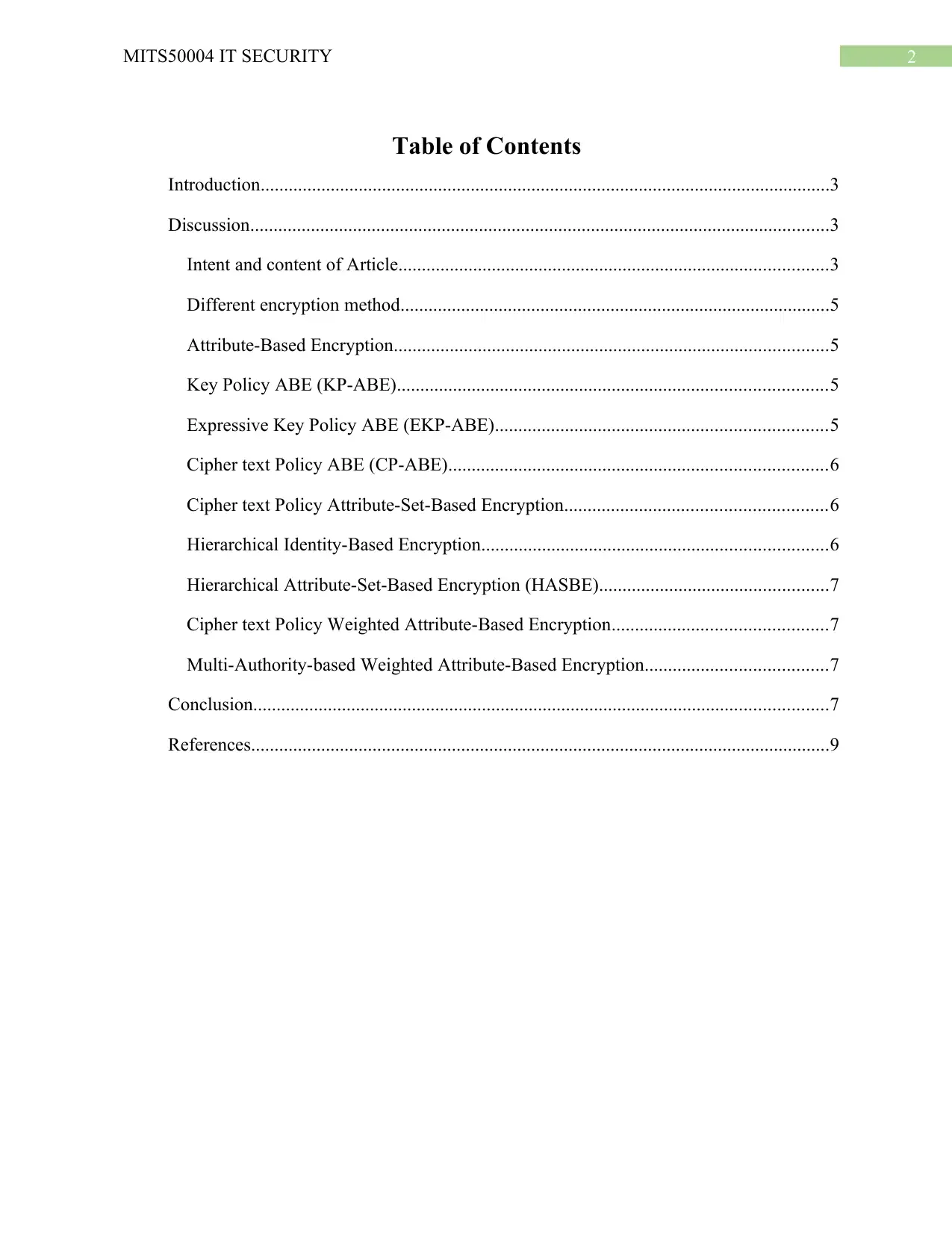
2MITS50004 IT SECURITY
Table of Contents
Introduction..........................................................................................................................3
Discussion............................................................................................................................3
Intent and content of Article............................................................................................3
Different encryption method............................................................................................5
Attribute-Based Encryption.............................................................................................5
Key Policy ABE (KP-ABE)............................................................................................5
Expressive Key Policy ABE (EKP-ABE).......................................................................5
Cipher text Policy ABE (CP-ABE).................................................................................6
Cipher text Policy Attribute-Set-Based Encryption........................................................6
Hierarchical Identity-Based Encryption..........................................................................6
Hierarchical Attribute-Set-Based Encryption (HASBE).................................................7
Cipher text Policy Weighted Attribute-Based Encryption..............................................7
Multi-Authority-based Weighted Attribute-Based Encryption.......................................7
Conclusion...........................................................................................................................7
References............................................................................................................................9
Table of Contents
Introduction..........................................................................................................................3
Discussion............................................................................................................................3
Intent and content of Article............................................................................................3
Different encryption method............................................................................................5
Attribute-Based Encryption.............................................................................................5
Key Policy ABE (KP-ABE)............................................................................................5
Expressive Key Policy ABE (EKP-ABE).......................................................................5
Cipher text Policy ABE (CP-ABE).................................................................................6
Cipher text Policy Attribute-Set-Based Encryption........................................................6
Hierarchical Identity-Based Encryption..........................................................................6
Hierarchical Attribute-Set-Based Encryption (HASBE).................................................7
Cipher text Policy Weighted Attribute-Based Encryption..............................................7
Multi-Authority-based Weighted Attribute-Based Encryption.......................................7
Conclusion...........................................................................................................................7
References............................................................................................................................9
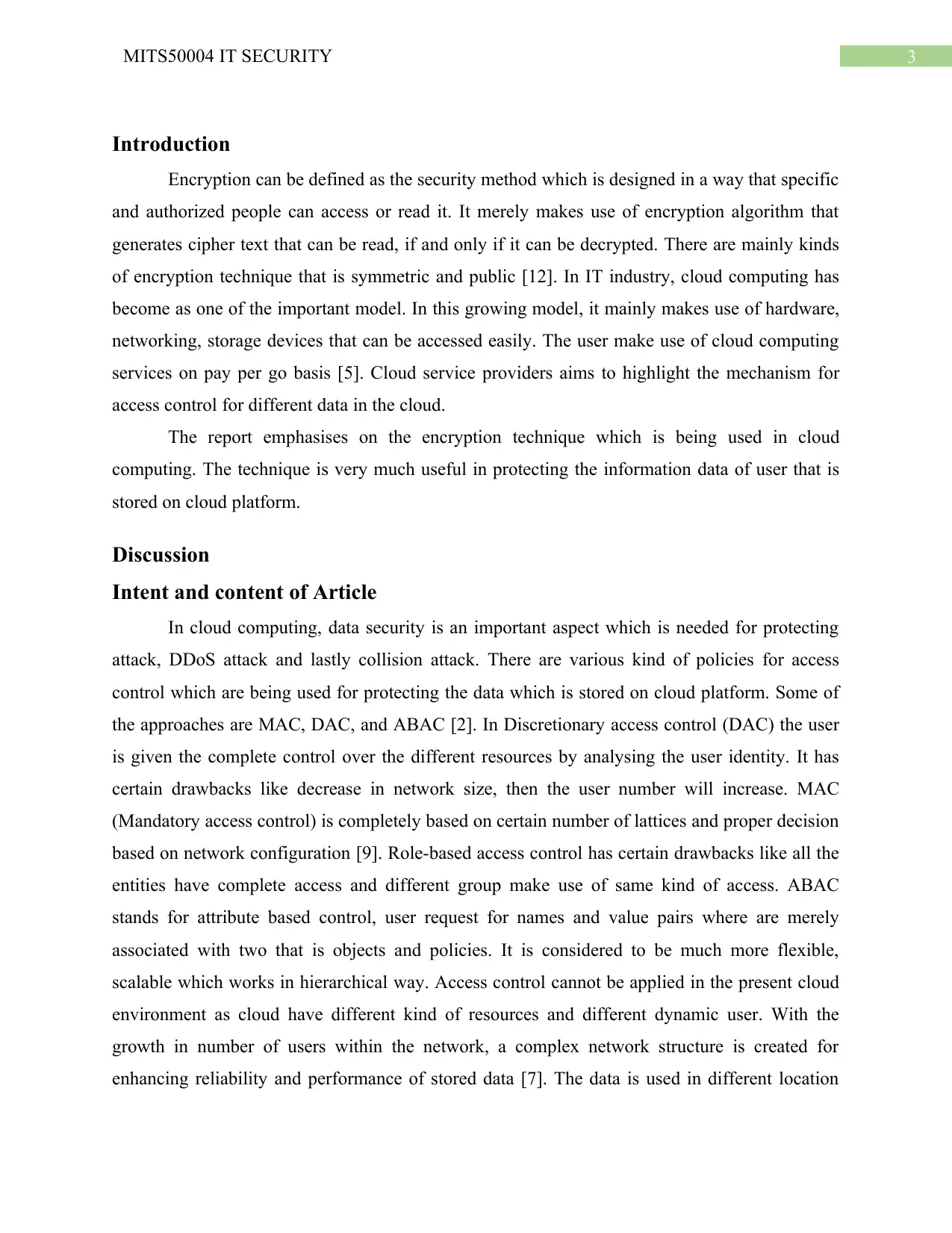
3MITS50004 IT SECURITY
Introduction
Encryption can be defined as the security method which is designed in a way that specific
and authorized people can access or read it. It merely makes use of encryption algorithm that
generates cipher text that can be read, if and only if it can be decrypted. There are mainly kinds
of encryption technique that is symmetric and public [12]. In IT industry, cloud computing has
become as one of the important model. In this growing model, it mainly makes use of hardware,
networking, storage devices that can be accessed easily. The user make use of cloud computing
services on pay per go basis [5]. Cloud service providers aims to highlight the mechanism for
access control for different data in the cloud.
The report emphasises on the encryption technique which is being used in cloud
computing. The technique is very much useful in protecting the information data of user that is
stored on cloud platform.
Discussion
Intent and content of Article
In cloud computing, data security is an important aspect which is needed for protecting
attack, DDoS attack and lastly collision attack. There are various kind of policies for access
control which are being used for protecting the data which is stored on cloud platform. Some of
the approaches are MAC, DAC, and ABAC [2]. In Discretionary access control (DAC) the user
is given the complete control over the different resources by analysing the user identity. It has
certain drawbacks like decrease in network size, then the user number will increase. MAC
(Mandatory access control) is completely based on certain number of lattices and proper decision
based on network configuration [9]. Role-based access control has certain drawbacks like all the
entities have complete access and different group make use of same kind of access. ABAC
stands for attribute based control, user request for names and value pairs where are merely
associated with two that is objects and policies. It is considered to be much more flexible,
scalable which works in hierarchical way. Access control cannot be applied in the present cloud
environment as cloud have different kind of resources and different dynamic user. With the
growth in number of users within the network, a complex network structure is created for
enhancing reliability and performance of stored data [7]. The data is used in different location
Introduction
Encryption can be defined as the security method which is designed in a way that specific
and authorized people can access or read it. It merely makes use of encryption algorithm that
generates cipher text that can be read, if and only if it can be decrypted. There are mainly kinds
of encryption technique that is symmetric and public [12]. In IT industry, cloud computing has
become as one of the important model. In this growing model, it mainly makes use of hardware,
networking, storage devices that can be accessed easily. The user make use of cloud computing
services on pay per go basis [5]. Cloud service providers aims to highlight the mechanism for
access control for different data in the cloud.
The report emphasises on the encryption technique which is being used in cloud
computing. The technique is very much useful in protecting the information data of user that is
stored on cloud platform.
Discussion
Intent and content of Article
In cloud computing, data security is an important aspect which is needed for protecting
attack, DDoS attack and lastly collision attack. There are various kind of policies for access
control which are being used for protecting the data which is stored on cloud platform. Some of
the approaches are MAC, DAC, and ABAC [2]. In Discretionary access control (DAC) the user
is given the complete control over the different resources by analysing the user identity. It has
certain drawbacks like decrease in network size, then the user number will increase. MAC
(Mandatory access control) is completely based on certain number of lattices and proper decision
based on network configuration [9]. Role-based access control has certain drawbacks like all the
entities have complete access and different group make use of same kind of access. ABAC
stands for attribute based control, user request for names and value pairs where are merely
associated with two that is objects and policies. It is considered to be much more flexible,
scalable which works in hierarchical way. Access control cannot be applied in the present cloud
environment as cloud have different kind of resources and different dynamic user. With the
growth in number of users within the network, a complex network structure is created for
enhancing reliability and performance of stored data [7]. The data is used in different location
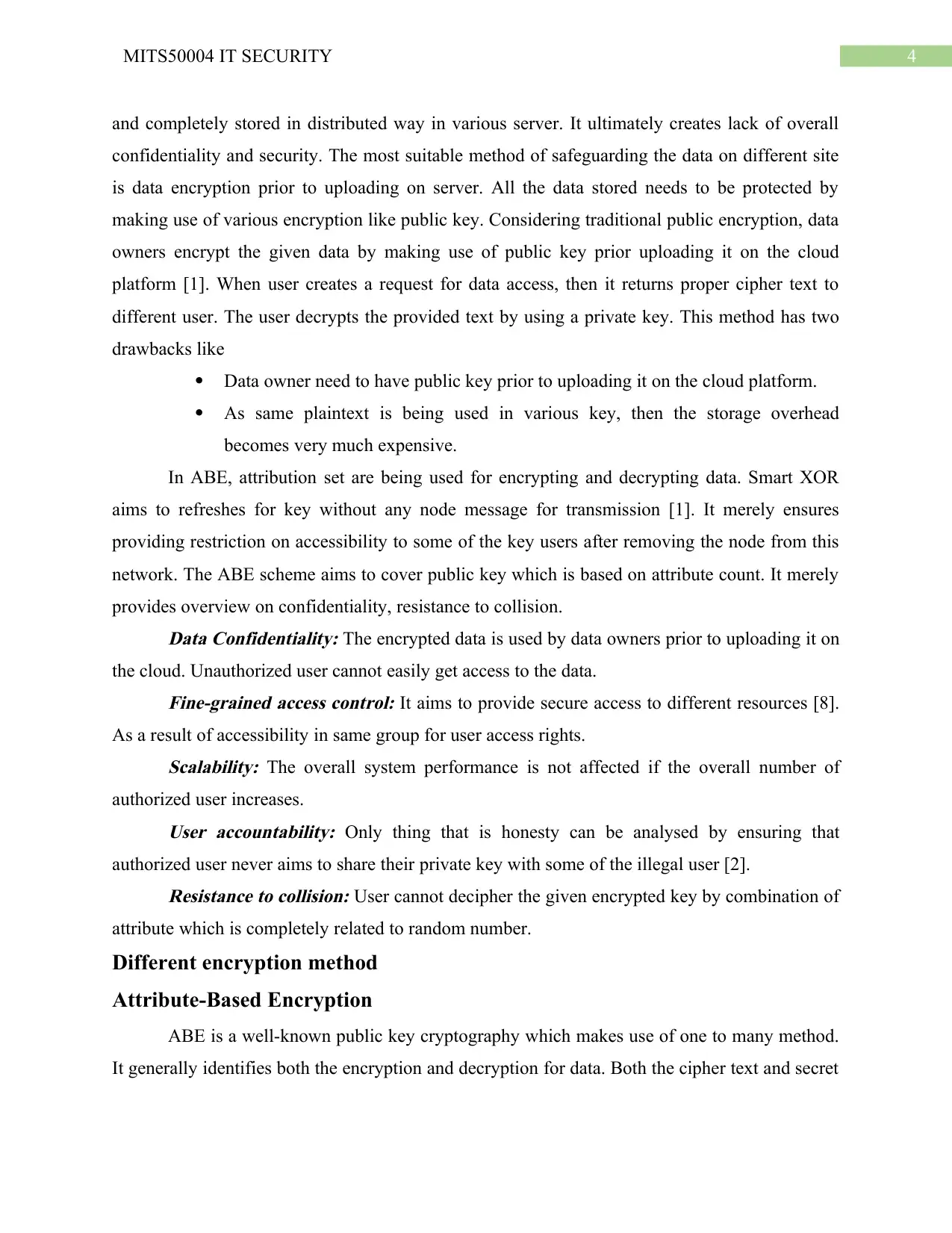
4MITS50004 IT SECURITY
and completely stored in distributed way in various server. It ultimately creates lack of overall
confidentiality and security. The most suitable method of safeguarding the data on different site
is data encryption prior to uploading on server. All the data stored needs to be protected by
making use of various encryption like public key. Considering traditional public encryption, data
owners encrypt the given data by making use of public key prior uploading it on the cloud
platform [1]. When user creates a request for data access, then it returns proper cipher text to
different user. The user decrypts the provided text by using a private key. This method has two
drawbacks like
Data owner need to have public key prior to uploading it on the cloud platform.
As same plaintext is being used in various key, then the storage overhead
becomes very much expensive.
In ABE, attribution set are being used for encrypting and decrypting data. Smart XOR
aims to refreshes for key without any node message for transmission [1]. It merely ensures
providing restriction on accessibility to some of the key users after removing the node from this
network. The ABE scheme aims to cover public key which is based on attribute count. It merely
provides overview on confidentiality, resistance to collision.
Data Confidentiality: The encrypted data is used by data owners prior to uploading it on
the cloud. Unauthorized user cannot easily get access to the data.
Fine-grained access control: It aims to provide secure access to different resources [8].
As a result of accessibility in same group for user access rights.
Scalability: The overall system performance is not affected if the overall number of
authorized user increases.
User accountability: Only thing that is honesty can be analysed by ensuring that
authorized user never aims to share their private key with some of the illegal user [2].
Resistance to collision: User cannot decipher the given encrypted key by combination of
attribute which is completely related to random number.
Different encryption method
Attribute-Based Encryption
ABE is a well-known public key cryptography which makes use of one to many method.
It generally identifies both the encryption and decryption for data. Both the cipher text and secret
and completely stored in distributed way in various server. It ultimately creates lack of overall
confidentiality and security. The most suitable method of safeguarding the data on different site
is data encryption prior to uploading on server. All the data stored needs to be protected by
making use of various encryption like public key. Considering traditional public encryption, data
owners encrypt the given data by making use of public key prior uploading it on the cloud
platform [1]. When user creates a request for data access, then it returns proper cipher text to
different user. The user decrypts the provided text by using a private key. This method has two
drawbacks like
Data owner need to have public key prior to uploading it on the cloud platform.
As same plaintext is being used in various key, then the storage overhead
becomes very much expensive.
In ABE, attribution set are being used for encrypting and decrypting data. Smart XOR
aims to refreshes for key without any node message for transmission [1]. It merely ensures
providing restriction on accessibility to some of the key users after removing the node from this
network. The ABE scheme aims to cover public key which is based on attribute count. It merely
provides overview on confidentiality, resistance to collision.
Data Confidentiality: The encrypted data is used by data owners prior to uploading it on
the cloud. Unauthorized user cannot easily get access to the data.
Fine-grained access control: It aims to provide secure access to different resources [8].
As a result of accessibility in same group for user access rights.
Scalability: The overall system performance is not affected if the overall number of
authorized user increases.
User accountability: Only thing that is honesty can be analysed by ensuring that
authorized user never aims to share their private key with some of the illegal user [2].
Resistance to collision: User cannot decipher the given encrypted key by combination of
attribute which is completely related to random number.
Different encryption method
Attribute-Based Encryption
ABE is a well-known public key cryptography which makes use of one to many method.
It generally identifies both the encryption and decryption for data. Both the cipher text and secret
Secure Best Marks with AI Grader
Need help grading? Try our AI Grader for instant feedback on your assignments.
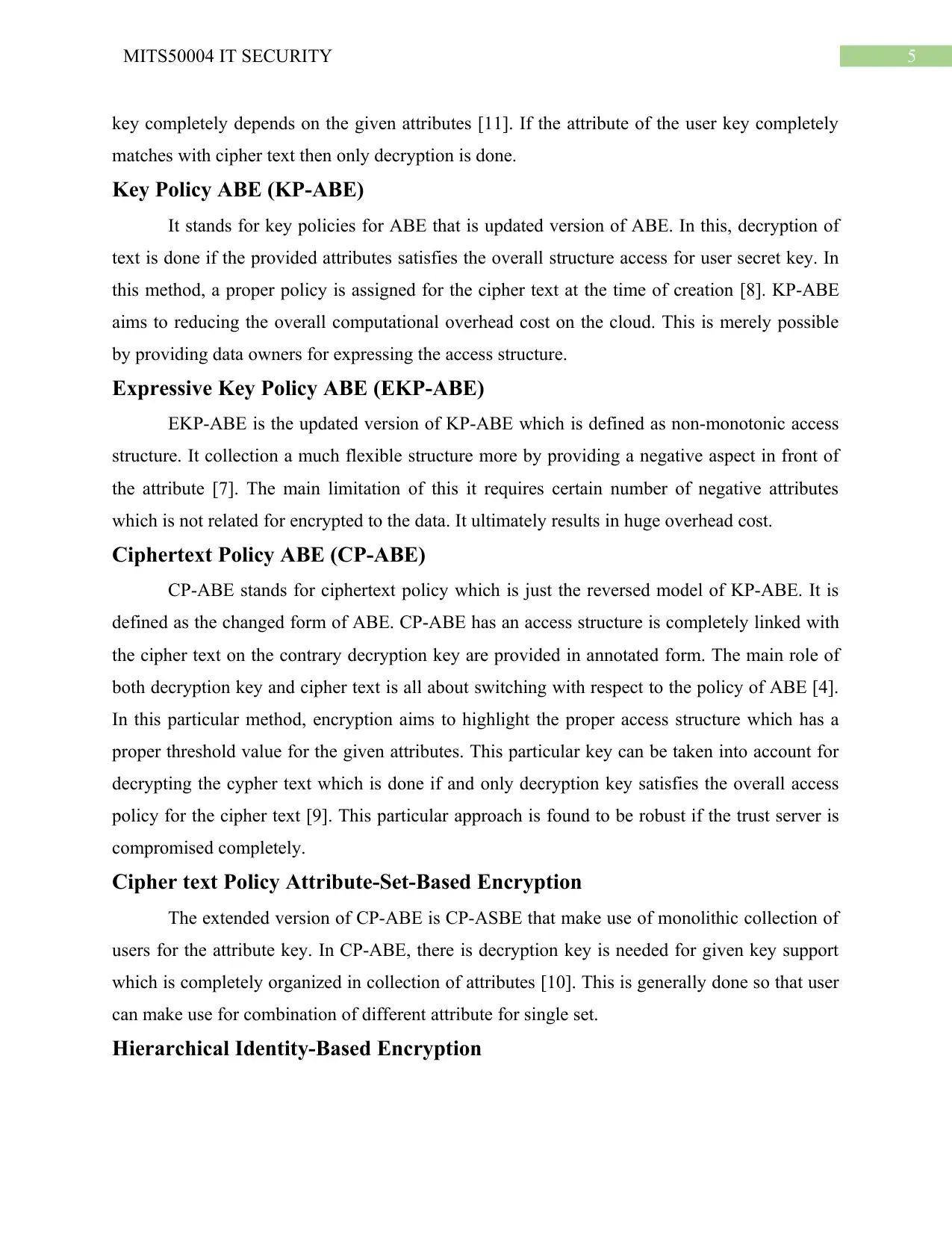
5MITS50004 IT SECURITY
key completely depends on the given attributes [11]. If the attribute of the user key completely
matches with cipher text then only decryption is done.
Key Policy ABE (KP-ABE)
It stands for key policies for ABE that is updated version of ABE. In this, decryption of
text is done if the provided attributes satisfies the overall structure access for user secret key. In
this method, a proper policy is assigned for the cipher text at the time of creation [8]. KP-ABE
aims to reducing the overall computational overhead cost on the cloud. This is merely possible
by providing data owners for expressing the access structure.
Expressive Key Policy ABE (EKP-ABE)
EKP-ABE is the updated version of KP-ABE which is defined as non-monotonic access
structure. It collection a much flexible structure more by providing a negative aspect in front of
the attribute [7]. The main limitation of this it requires certain number of negative attributes
which is not related for encrypted to the data. It ultimately results in huge overhead cost.
Ciphertext Policy ABE (CP-ABE)
CP-ABE stands for ciphertext policy which is just the reversed model of KP-ABE. It is
defined as the changed form of ABE. CP-ABE has an access structure is completely linked with
the cipher text on the contrary decryption key are provided in annotated form. The main role of
both decryption key and cipher text is all about switching with respect to the policy of ABE [4].
In this particular method, encryption aims to highlight the proper access structure which has a
proper threshold value for the given attributes. This particular key can be taken into account for
decrypting the cypher text which is done if and only decryption key satisfies the overall access
policy for the cipher text [9]. This particular approach is found to be robust if the trust server is
compromised completely.
Cipher text Policy Attribute-Set-Based Encryption
The extended version of CP-ABE is CP-ASBE that make use of monolithic collection of
users for the attribute key. In CP-ABE, there is decryption key is needed for given key support
which is completely organized in collection of attributes [10]. This is generally done so that user
can make use for combination of different attribute for single set.
Hierarchical Identity-Based Encryption
key completely depends on the given attributes [11]. If the attribute of the user key completely
matches with cipher text then only decryption is done.
Key Policy ABE (KP-ABE)
It stands for key policies for ABE that is updated version of ABE. In this, decryption of
text is done if the provided attributes satisfies the overall structure access for user secret key. In
this method, a proper policy is assigned for the cipher text at the time of creation [8]. KP-ABE
aims to reducing the overall computational overhead cost on the cloud. This is merely possible
by providing data owners for expressing the access structure.
Expressive Key Policy ABE (EKP-ABE)
EKP-ABE is the updated version of KP-ABE which is defined as non-monotonic access
structure. It collection a much flexible structure more by providing a negative aspect in front of
the attribute [7]. The main limitation of this it requires certain number of negative attributes
which is not related for encrypted to the data. It ultimately results in huge overhead cost.
Ciphertext Policy ABE (CP-ABE)
CP-ABE stands for ciphertext policy which is just the reversed model of KP-ABE. It is
defined as the changed form of ABE. CP-ABE has an access structure is completely linked with
the cipher text on the contrary decryption key are provided in annotated form. The main role of
both decryption key and cipher text is all about switching with respect to the policy of ABE [4].
In this particular method, encryption aims to highlight the proper access structure which has a
proper threshold value for the given attributes. This particular key can be taken into account for
decrypting the cypher text which is done if and only decryption key satisfies the overall access
policy for the cipher text [9]. This particular approach is found to be robust if the trust server is
compromised completely.
Cipher text Policy Attribute-Set-Based Encryption
The extended version of CP-ABE is CP-ASBE that make use of monolithic collection of
users for the attribute key. In CP-ABE, there is decryption key is needed for given key support
which is completely organized in collection of attributes [10]. This is generally done so that user
can make use for combination of different attribute for single set.
Hierarchical Identity-Based Encryption
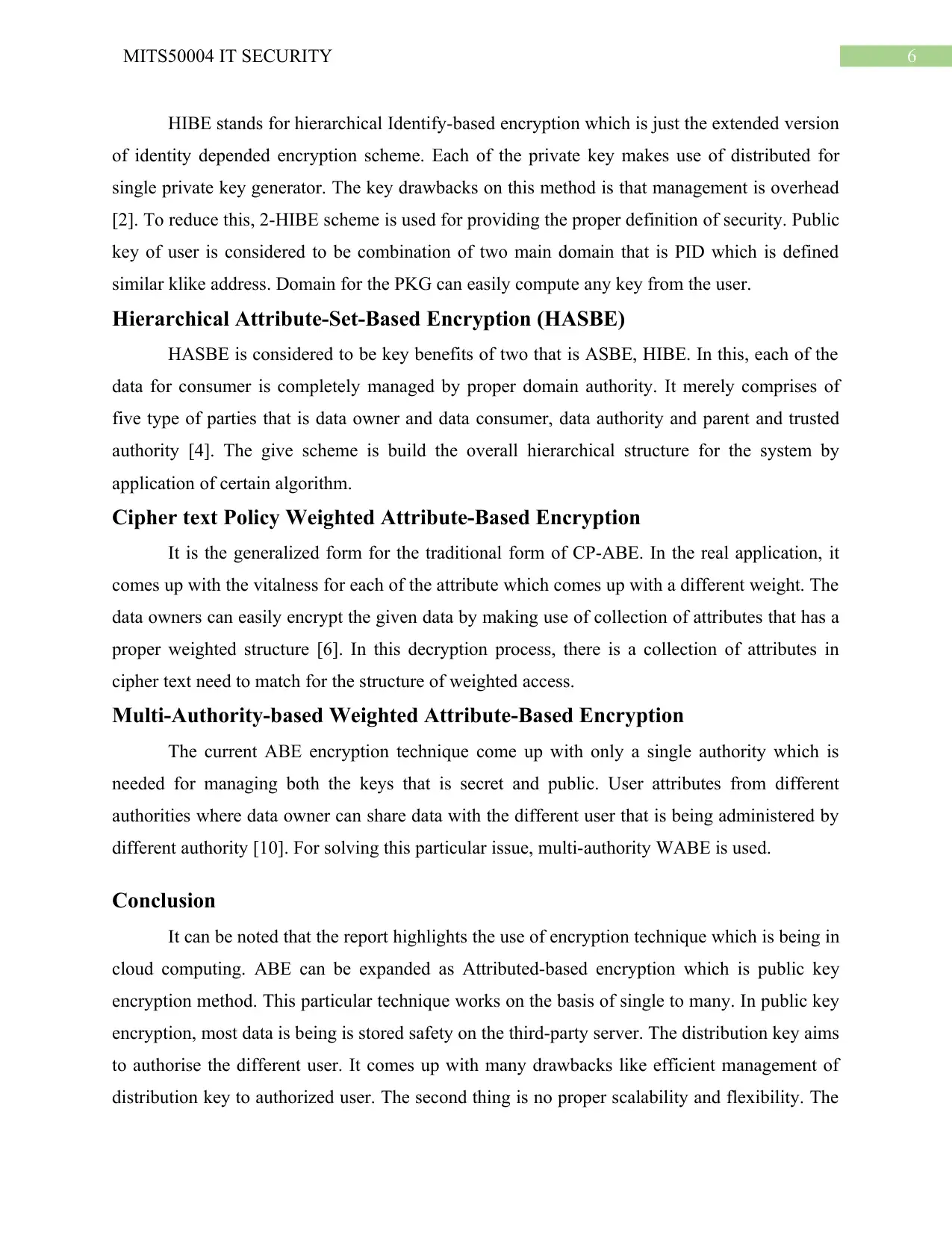
6MITS50004 IT SECURITY
HIBE stands for hierarchical Identify-based encryption which is just the extended version
of identity depended encryption scheme. Each of the private key makes use of distributed for
single private key generator. The key drawbacks on this method is that management is overhead
[2]. To reduce this, 2-HIBE scheme is used for providing the proper definition of security. Public
key of user is considered to be combination of two main domain that is PID which is defined
similar klike address. Domain for the PKG can easily compute any key from the user.
Hierarchical Attribute-Set-Based Encryption (HASBE)
HASBE is considered to be key benefits of two that is ASBE, HIBE. In this, each of the
data for consumer is completely managed by proper domain authority. It merely comprises of
five type of parties that is data owner and data consumer, data authority and parent and trusted
authority [4]. The give scheme is build the overall hierarchical structure for the system by
application of certain algorithm.
Cipher text Policy Weighted Attribute-Based Encryption
It is the generalized form for the traditional form of CP-ABE. In the real application, it
comes up with the vitalness for each of the attribute which comes up with a different weight. The
data owners can easily encrypt the given data by making use of collection of attributes that has a
proper weighted structure [6]. In this decryption process, there is a collection of attributes in
cipher text need to match for the structure of weighted access.
Multi-Authority-based Weighted Attribute-Based Encryption
The current ABE encryption technique come up with only a single authority which is
needed for managing both the keys that is secret and public. User attributes from different
authorities where data owner can share data with the different user that is being administered by
different authority [10]. For solving this particular issue, multi-authority WABE is used.
Conclusion
It can be noted that the report highlights the use of encryption technique which is being in
cloud computing. ABE can be expanded as Attributed-based encryption which is public key
encryption method. This particular technique works on the basis of single to many. In public key
encryption, most data is being is stored safety on the third-party server. The distribution key aims
to authorise the different user. It comes up with many drawbacks like efficient management of
distribution key to authorized user. The second thing is no proper scalability and flexibility. The
HIBE stands for hierarchical Identify-based encryption which is just the extended version
of identity depended encryption scheme. Each of the private key makes use of distributed for
single private key generator. The key drawbacks on this method is that management is overhead
[2]. To reduce this, 2-HIBE scheme is used for providing the proper definition of security. Public
key of user is considered to be combination of two main domain that is PID which is defined
similar klike address. Domain for the PKG can easily compute any key from the user.
Hierarchical Attribute-Set-Based Encryption (HASBE)
HASBE is considered to be key benefits of two that is ASBE, HIBE. In this, each of the
data for consumer is completely managed by proper domain authority. It merely comprises of
five type of parties that is data owner and data consumer, data authority and parent and trusted
authority [4]. The give scheme is build the overall hierarchical structure for the system by
application of certain algorithm.
Cipher text Policy Weighted Attribute-Based Encryption
It is the generalized form for the traditional form of CP-ABE. In the real application, it
comes up with the vitalness for each of the attribute which comes up with a different weight. The
data owners can easily encrypt the given data by making use of collection of attributes that has a
proper weighted structure [6]. In this decryption process, there is a collection of attributes in
cipher text need to match for the structure of weighted access.
Multi-Authority-based Weighted Attribute-Based Encryption
The current ABE encryption technique come up with only a single authority which is
needed for managing both the keys that is secret and public. User attributes from different
authorities where data owner can share data with the different user that is being administered by
different authority [10]. For solving this particular issue, multi-authority WABE is used.
Conclusion
It can be noted that the report highlights the use of encryption technique which is being in
cloud computing. ABE can be expanded as Attributed-based encryption which is public key
encryption method. This particular technique works on the basis of single to many. In public key
encryption, most data is being is stored safety on the third-party server. The distribution key aims
to authorise the different user. It comes up with many drawbacks like efficient management of
distribution key to authorized user. The second thing is no proper scalability and flexibility. The

7MITS50004 IT SECURITY
third aspect is that data owners should be online which is needed for encrypting and decrypting
data. The main function of ABE is all about reducing the overhead communication for internet
and improved scalability. Access control is the method of restricting or denying access to the
system. In the domain of cloud computing, data security is one of the important aspect for
protecting inside attack, DDoS attack and collision attack.
third aspect is that data owners should be online which is needed for encrypting and decrypting
data. The main function of ABE is all about reducing the overhead communication for internet
and improved scalability. Access control is the method of restricting or denying access to the
system. In the domain of cloud computing, data security is one of the important aspect for
protecting inside attack, DDoS attack and collision attack.
Paraphrase This Document
Need a fresh take? Get an instant paraphrase of this document with our AI Paraphraser
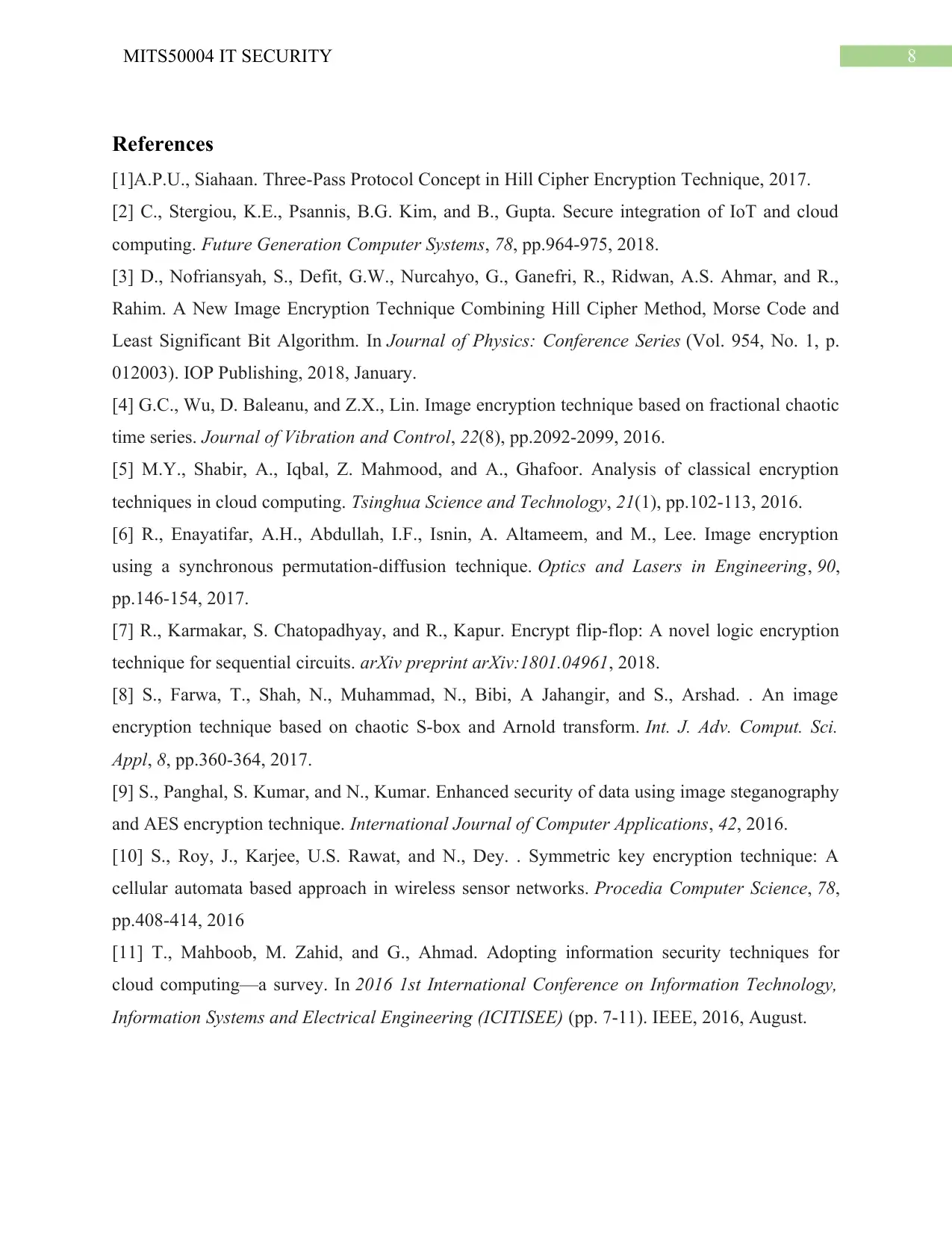
8MITS50004 IT SECURITY
References
[1]A.P.U., Siahaan. Three-Pass Protocol Concept in Hill Cipher Encryption Technique, 2017.
[2] C., Stergiou, K.E., Psannis, B.G. Kim, and B., Gupta. Secure integration of IoT and cloud
computing. Future Generation Computer Systems, 78, pp.964-975, 2018.
[3] D., Nofriansyah, S., Defit, G.W., Nurcahyo, G., Ganefri, R., Ridwan, A.S. Ahmar, and R.,
Rahim. A New Image Encryption Technique Combining Hill Cipher Method, Morse Code and
Least Significant Bit Algorithm. In Journal of Physics: Conference Series (Vol. 954, No. 1, p.
012003). IOP Publishing, 2018, January.
[4] G.C., Wu, D. Baleanu, and Z.X., Lin. Image encryption technique based on fractional chaotic
time series. Journal of Vibration and Control, 22(8), pp.2092-2099, 2016.
[5] M.Y., Shabir, A., Iqbal, Z. Mahmood, and A., Ghafoor. Analysis of classical encryption
techniques in cloud computing. Tsinghua Science and Technology, 21(1), pp.102-113, 2016.
[6] R., Enayatifar, A.H., Abdullah, I.F., Isnin, A. Altameem, and M., Lee. Image encryption
using a synchronous permutation-diffusion technique. Optics and Lasers in Engineering, 90,
pp.146-154, 2017.
[7] R., Karmakar, S. Chatopadhyay, and R., Kapur. Encrypt flip-flop: A novel logic encryption
technique for sequential circuits. arXiv preprint arXiv:1801.04961, 2018.
[8] S., Farwa, T., Shah, N., Muhammad, N., Bibi, A Jahangir, and S., Arshad. . An image
encryption technique based on chaotic S-box and Arnold transform. Int. J. Adv. Comput. Sci.
Appl, 8, pp.360-364, 2017.
[9] S., Panghal, S. Kumar, and N., Kumar. Enhanced security of data using image steganography
and AES encryption technique. International Journal of Computer Applications, 42, 2016.
[10] S., Roy, J., Karjee, U.S. Rawat, and N., Dey. . Symmetric key encryption technique: A
cellular automata based approach in wireless sensor networks. Procedia Computer Science, 78,
pp.408-414, 2016
[11] T., Mahboob, M. Zahid, and G., Ahmad. Adopting information security techniques for
cloud computing—a survey. In 2016 1st International Conference on Information Technology,
Information Systems and Electrical Engineering (ICITISEE) (pp. 7-11). IEEE, 2016, August.
References
[1]A.P.U., Siahaan. Three-Pass Protocol Concept in Hill Cipher Encryption Technique, 2017.
[2] C., Stergiou, K.E., Psannis, B.G. Kim, and B., Gupta. Secure integration of IoT and cloud
computing. Future Generation Computer Systems, 78, pp.964-975, 2018.
[3] D., Nofriansyah, S., Defit, G.W., Nurcahyo, G., Ganefri, R., Ridwan, A.S. Ahmar, and R.,
Rahim. A New Image Encryption Technique Combining Hill Cipher Method, Morse Code and
Least Significant Bit Algorithm. In Journal of Physics: Conference Series (Vol. 954, No. 1, p.
012003). IOP Publishing, 2018, January.
[4] G.C., Wu, D. Baleanu, and Z.X., Lin. Image encryption technique based on fractional chaotic
time series. Journal of Vibration and Control, 22(8), pp.2092-2099, 2016.
[5] M.Y., Shabir, A., Iqbal, Z. Mahmood, and A., Ghafoor. Analysis of classical encryption
techniques in cloud computing. Tsinghua Science and Technology, 21(1), pp.102-113, 2016.
[6] R., Enayatifar, A.H., Abdullah, I.F., Isnin, A. Altameem, and M., Lee. Image encryption
using a synchronous permutation-diffusion technique. Optics and Lasers in Engineering, 90,
pp.146-154, 2017.
[7] R., Karmakar, S. Chatopadhyay, and R., Kapur. Encrypt flip-flop: A novel logic encryption
technique for sequential circuits. arXiv preprint arXiv:1801.04961, 2018.
[8] S., Farwa, T., Shah, N., Muhammad, N., Bibi, A Jahangir, and S., Arshad. . An image
encryption technique based on chaotic S-box and Arnold transform. Int. J. Adv. Comput. Sci.
Appl, 8, pp.360-364, 2017.
[9] S., Panghal, S. Kumar, and N., Kumar. Enhanced security of data using image steganography
and AES encryption technique. International Journal of Computer Applications, 42, 2016.
[10] S., Roy, J., Karjee, U.S. Rawat, and N., Dey. . Symmetric key encryption technique: A
cellular automata based approach in wireless sensor networks. Procedia Computer Science, 78,
pp.408-414, 2016
[11] T., Mahboob, M. Zahid, and G., Ahmad. Adopting information security techniques for
cloud computing—a survey. In 2016 1st International Conference on Information Technology,
Information Systems and Electrical Engineering (ICITISEE) (pp. 7-11). IEEE, 2016, August.

9MITS50004 IT SECURITY
[12] Z., Xia, X., Wang, L., Zhang, Z., Qin, X. Sun, and K., Ren. A privacy-preserving and copy-
deterrence content-based image retrieval scheme in cloud computing. IEEE Transactions on
Information Forensics and Security, 11(11), pp.2594-2608, 2016.
[12] Z., Xia, X., Wang, L., Zhang, Z., Qin, X. Sun, and K., Ren. A privacy-preserving and copy-
deterrence content-based image retrieval scheme in cloud computing. IEEE Transactions on
Information Forensics and Security, 11(11), pp.2594-2608, 2016.
1 out of 9
Related Documents
Your All-in-One AI-Powered Toolkit for Academic Success.
+13062052269
info@desklib.com
Available 24*7 on WhatsApp / Email
![[object Object]](/_next/static/media/star-bottom.7253800d.svg)
Unlock your academic potential
© 2024 | Zucol Services PVT LTD | All rights reserved.




